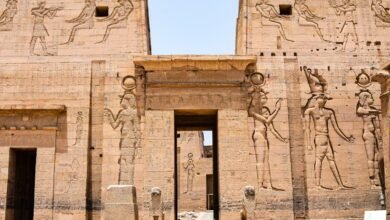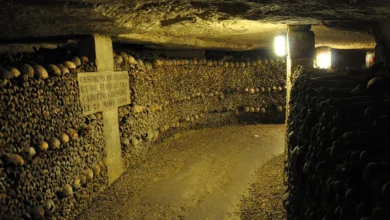
Exploring the Majestic Kailasa Temple at Ellora: A Marvel of Ancient Architecture
Nestled amidst the breathtaking landscape of Aurangabad district in Maharashtra, India, the Kailasa Temple, also known as Kailashanatha Temple, stands as a masterpiece of rock-cut Hindu architecture. Carved into the imposing rock cliffs of the Ellora Caves, this awe-inspiring temple complex is a testament to the ingenuity, craftsmanship, and devotion of ancient artisans. Let’s embark on a virtual journey to unravel the remarkable features and intriguing history of the Kailasa Temple.
Majestic Architecture and Unparalleled Size:
The Kailasa Temple reigns as the grandest among the 34 cave temples at the Ellora site. Carved from a monolithic rock face, it astonishes with its colossal size, intricate design, and captivating sculptural treatment. Considered a pinnacle of the rock-cut architectural style, the temple soars to a height of 32.6 meters above its courtyard, showcasing a splendid fusion of Pallava and Chalukya influences.

A Glimpse into History:
While the exact origin of the Kailasa Temple lacks a definitive inscription, it is widely attributed to the Rashtrakuta dynasty, particularly the reign of King Krishna I. The temple’s construction is a triumph of human determination and engineering prowess. As legends and inscriptions suggest, the temple may have been commissioned as a divine offering, seeking blessings from the deity within its sacred precincts.
Intricate Details and Sculptural Marvels:
Exploring the temple’s vast expanse, visitors are greeted by a rich array of intricate sculptures and relief panels. These artistic marvels narrate stories from Hindu epics, depict deities in various forms, and offer a glimpse into the spiritual and cultural tapestry of ancient India. The temple’s facade showcases awe-inspiring sculptures, including the iconic portrayal of Ravana shaking Mount Kailasa, a scene of profound significance.









A Symphony of Styles and Influences:
The Kailasa Temple’s architectural diversity astounds observers, hinting at the collaboration of various artistic schools. The fusion of Pallava, Chalukya, and Deccan styles creates a harmonious symphony of architectural elements. The temple’s meticulous planning, evident from its vertical excavation and intricate design, reflects the masterful expertise of its creators.

A Visionary Construction Method:
The temple’s construction method adds to its allure. Carvers ingeniously began their work from the top, excavating downward, showcasing an unparalleled level of planning and execution. This unique approach set the Kailasa Temple apart as an architectural marvel that defied conventional construction norms of its time.

Stone carvings of Ellora
A Testament to Enduring Legacy:
The Kailasa Temple stands as a timeless testament to the creativity, devotion, and expertise of ancient Indian artisans. Its walls whisper tales of bygone eras, invoking a sense of wonder and reverence. As visitors traverse the corridors and courtyards, they connect with the spiritual essence of a bygone age, immersed in a world where art and faith converged.

Preserving a Living Legacy:
Today, the Kailasa Temple continues to inspire awe and reverence, drawing visitors from around the world to witness its unparalleled beauty and architectural significance. This living legacy reminds us of the enduring power of human creativity and devotion, inviting us to reflect on the profound connection between art, culture, and spirituality.

Close-up of Elephant on the Base of Kailasa Temple
Intricate carvings, monumental sculptures, and a rich historical tapestry converge within the breathtaking Kailasa Temple at Ellora, inviting modern admirers to journey through time and immerse themselves in the splendor of ancient craftsmanship. As you contemplate the marvels of this sacred sanctuary, you’re reminded of the remarkable ability of human hands to shape not only rock but also the course of history itself.





